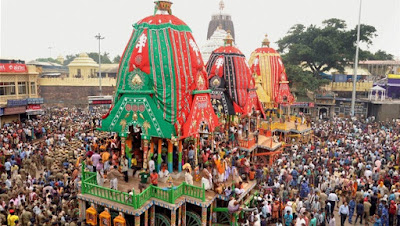Car Festival in English and Ratha Yatra in ODIA, the Festival of Chariots of
Lord Jagannatha is going to be celebrated on 18th July this year
2015 at Puri, the temple city in Orissa, on the south eastern coast of India. It's also is the Year of "NABA KALEBAR" means new renovated God will appear to people. The presiding deities of the main temple, Sri Mandira, Lord Jagannatha, Lord
Balabhadra and Goddess Subhadra, with the celestial wheel Sudarshana are taken
out from the temple precincts in an elaborate ritual procession to their
respective chariots Nandighosh, Taladhwoj and Debadalan. The huge, colorfully decorated chariots, are drawn by
hundreds and thousands of devotees on the BADA DANDA, the grand avenue to the
Gundicha temple, called MAUSIMA temple- the birth place of Gods, some two miles
away to the North. After a stay for seven days, the deities return to their
abode in Sri Mandira.
 |
| CAR FESTIVAL or RATHA YATRA of Puri, Odisha, India |
Ratha Yatra is perhaps the grandest festival on India or even world.
Everything is on a scale befitting the great Lord. Full of spectacle, drama and
color, the festival is a typical Indian fair of huge proportions. It is also
the living embodiment of the synthesis of the tribal, the folk, and the
autochthonous with the classical, the elaborately formal and the sophisticated
elements of the socio-cultural-religious ethos of the Indian civilization.
Significance of Ratha Yatra:
The festival is also known as Sri Gundicha Yatra, Ghosa Yatra, Navadina
Yatra, Dasavatara Yatra and by a variety of similar names. For the devoted and
believers, it is considered the most auspicious occasion for Odia People.
Yatra is an essential part of the ritual of the Hinduism culture of worship.
Yatra literally means travel or journey. Normally, it is the representative
deities of temples more popularly known as Utsava Murti in south and Chalanti
Pratima or Bije Pratima in Odisha, partake in these journeys. It is rarely that
the presiding deities come out of the sanctum for such ritual journeys. The Yatra
for the Ritual Journey take two forms – one involving the short circulation
around the temple and other involving a longer journey from the temple to some
other destination. The Yatra is considered as an important part of festivities
and ceremonies of each temple and is considered as a special and sacred
occasion all over the world where ODIAS present.
Rath Yatra being unique among all Yatras is the grandest festival of the
supreme divinity who has manifested himself in the Kali Yuga to emancipate
humanity and to relieve them from their sufferings. Lord Jagannatha is identified
fully with Vishnu and Krishna. In his original manifestation as NilaMadhaba, he
was worshipped in a sacred Nyagrodha Briksha or banyan tree. The branches of
the tree had spread for several miles and anyone entering this area was
instantly emancipated and was relieved of the travails of the birth and
re-birth. In fact, the influence of Yama, the God of Death, is supposed to have
been curtailed in the sacred city of Puri – Srikshetra on account of the
presence of Lord Jagannatha and therefore it is also called the Yamanika
Tirtha.
Please come and enjoy the RATHA YATRA on 18th July 2015 at Puri,
Bhubaneswar all over Odisha, all over India and the World where ODIAs and Hindus are present,
worship and get the divine wishes from the Lords of Universe. Please do not
forget to share me your feeling after enjoying this auspicious car festival.
JAI JAGANNATH !!!








